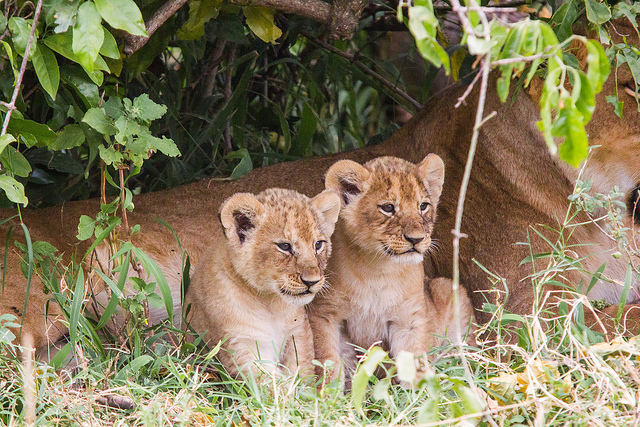為因應野外獅群數量驟減,美國魚類及野生動物管理局將兩種獅子亞種列入瀕危物種法保護對象。分佈印度和非洲中西部的巴巴里獅(Panthera leo leo)被列為瀕危物種;分布於東非和南非的開普獅(Panthera leo melanochaita)被列為受威脅物種。
非洲獅。圖片來源:Peter Steward(CC BY-NC 2.0)。
為時一年研究 二種非洲獅列為受威脅物種
過去20年,獅群數量由於棲地流失、獵物減少及人類報復性獵殺減少43%。加上各國缺乏資金和資源妥善管理保護區,嚴重影響野外獅群存續狀況。
2011年3月,管理局收到將非洲獅列為瀕危亞種的請願書;2014年10月,管理局發表12個月的研究結果,並提案將非洲獅列為受威脅物種。
魚類及野生動物管理局局長Dan Ashe發布局長命令,加強落實野生動物使用許可要求。依照歐巴馬的打擊野生動物盜獵國家的戰略,局長命令規定違反野生動物法者,未來不可取得野生動物相關活動許可,包括進口狩獵戰利品。
野外只有1000隻
根據最新的基因與分類學資料,管理局評估整個獅物種的狀態後修改了先前的研究發現。
最新科學證據顯示,非洲獅的西部和中部族群在基因上和亞洲獅較接近。這些獅子現在被歸類為相同的亞種「巴巴里獅」(Panthera leo leo)。目前這種獅在野外只剩下1400隻個體;非洲有14個族群、900隻個體,印度有523隻。
考量族群大小、分布狀況、族群趨勢和受威脅程度,管理局認定此亞種符合瀕危物種法對瀕危物種的定義。
另一亞種開普獅(Panthera leo melanochaita)的可能數量為1萬7000和1萬9000,分布於南非和東非。管理局認為此亞種的風險較小,目前較無滅絕危機。雖然南非整體獅群數量正在增加,部分族群仍因威脅持續存在而減少。因此管理局認為此亞種符合受威脅物種定義。
禁止進口或需經審查 保育、科研、展示都受規範
列入瀕危物種後,巴巴里獅將被禁止進口,除非有證據顯示進口活動有助於物種存續。
同時管理局也正在建立進口許可機制,規範開普獅部位和製品進入美國,包括活體和狩獵戰利品。新機制將確保進口樣品是在棲地國家經合法妥善的科學管理計畫之下取得,且該計畫有益野外族群。
管理局的新規定將能夠支持其他國家的獅群保育計畫,確保其治理效果與可靠性。妥善的管理計畫能透過戰利品狩獵的獲利資助獅群保育、研究和反盜獵。
未來科學研究、野外獅群保育活動、動物園展示和教育活動等也需要申請許可。
In response to the steep decline of lion populations in the wild, the U.S. Fish and Wildlife Service is listing two lion subspecies under the Endangered Species Act.
Panthera leo leo, located in India and western and central Africa, will be listed as endangered, and Panthera leo melanochaita, located in eastern and southern Africa, will be listed as threatened.
To protect lions and other wildlife from criminal activity, Fish and Wildlife Service Director Dan Ashe also issued a Director’s Order to strengthen enforcement of wildlife permitting requirements.
In line with President Barack Obama’s National Strategy for Combating Wildlife Trafficking, the order keeps violators of wildlife laws from being granted permits for future wildlife-related activities, including the import of sport-hunted trophies.
In the last 20 years, lion populations have declined by 43 percent due to habitat loss, loss of prey, and retaliatory killing of lions by a growing human population.
Coupled with inadequate financial and other resources for countries to effectively manage protected areas, the impact on lions in the wild has been devastating.
In March 2011, the Service received a petition to list the African lion subspecies as endangered. In October 2014, the Service published a 12-month finding and proposed a rule to list the African lion as threatened.
Based on newly available scientific information on the genetics and taxonomy of lions, the Service assessed the status of the entire lion species and changed its earlier finding.
The new science resolved that the western and central populations of African lion are more genetically related to the Asiatic lion. These lions are now considered the same subspecies, Panthera leo leo. There are only about 1,400 of these lions remaining in the wild; 900 in 14 African populations and 523 in India.
Considering the size and distribution of the lion populations, population trends and the severity of the threats, the Service has found that this subspecies meets the definition of endangered under the Endangered Species Act.
The lion subspecies Panthera leo melanochaita likely numbers between 17,000 and 19,000 and is found across southern and eastern Africa.
The Service determined that this subspecies is less vulnerable and is not currently in danger of extinction. Although lion numbers in southern Africa are increasing overall, there are populations that are declining due to ongoing threats. As a result, the Service finds the subspecies meets the definition of a threatened species under the Act.
With an endangered listing, imports of Panthera leo leo will generally be prohibited, except in certain cases, such as when it can be found that the import will enhance the survival of the species.
The Service is also finalizing a rule to establish a permitting mechanism regulating the import of all P. l. melanochaita parts and products, including live animals and sport-hunted trophies, into the United States.
The process will ensure that imported specimens are legally obtained in range countries as part of a scientifically sound management program that benefits the subspecies in the wild.
The final rule will allow the Service to support changes that strengthen the governance and accountability of conservation programs in other nations. Well-managed conservation programs use trophy hunting revenues to sustain lion conservation, research and anti-poaching activities.
Permits would also be required for scientific purposes, activities that enhance the propagation or survival of the subspecies in the wild, zoo exhibitions and educational purposes.
※ 全文及圖片詳見:ENS







